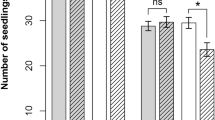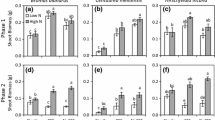Abstract
We tested the hypothesis that N enrichment modifies plant–soil feedback relationships, resulting in changes to plant community composition. This was done in a two-phase glasshouse experiment. In the first phase, we grew eight annual plant species in monoculture at two levels of N addition. Plants were harvested at senescence and the effect of each species on a range of soil properties was measured. In the second phase, the eight plant species were grown in multi-species mixtures in the eight soils conditioned by the species in the first phase, at both levels of N addition. At senescence, species performance was measured as aboveground biomass. We found that in the first phase, plant species identity strongly influenced several soil properties, including microbial and protist biomass, soil moisture content and the availability of several soil nutrients. Species effects on the soil were mostly independent of N addition and several were strongly correlated with plant biomass. In the second phase, both the performance of individual species and overall community structure were influenced by the interacting effects of the species identity of the previous soil occupant and the rate of N addition. This indicates that N enrichment modified plant–soil feedback. The performance of two species correlated with differences in soil N availability that were generated by the species formerly occupying the soil. However, negative feedback (poorer performance on the soil of conspecifics relative to that of heterospecifics) was only observed for one species. In conclusion, we provide evidence that N enrichment modifies plant–soil feedback relationships and that these modifications may affect plant community composition. Field testing and further investigations into which mechanisms dominate feedback are required before we fully understand how and when feedback processes determine plant community responses to N enrichment.


Similar content being viewed by others
References
Aerts R, Chapin FS (2000) The mineral nutrition of wild plants revisited: a re-evaluation of processes and patterns. Adv Ecol Res 30:1–66
Anon (2007) Integrated taxonomic information system. http://www.itis.usda.gov.index.html
Bardgett RD, Mawdsley JL, Edwards S, Hobbs PJ, Rodwell JS, Davies WJ (1999) Plant species and nitrogen effects on soil biological properties of temperate upland grasslands. Funct Ecol 13:650–660
Bardgett RD, Bowman WD, Kaufmann R, Schmidt SK (2005) A temporal approach to linking aboveground and belowground ecology. Trends Ecol Evol 20:634–641
Bever JD (1994) Feedbacks between plants and their soil communities in an old field community. Ecology 75:1965–1977
Bever JD, Westover KW, Antonovics J (1997) Incorporating the soil community into plant population dynamics: the utility of the feedback approach. J Ecol 85:561–573
Bezemer TM, Lawson CS, Hedlund K, Edwards AR, Brook AJ, Igual JM, Mortimer SR, van der Putten WH (2006) Plant species and functional group effects on abiotic and microbial soil properties and plant–soil feedback responses in two grasslands. J Ecol 94:893–904
Bobbink R, Hornung M, Roelofs JGM (1998) The effects of air-borne nitrogen pollutants on species diversity in natural and semi-natural European vegetation. J Ecol 86:717–738
Bonkowski M, Griffiths BS, Scrimgeour C (2000) Substrate heterogeneity and microfauna in soil organic ‘hotspots’ as determinants of nitrogen capture and growth of rye-grass. Appl Soil Ecol 14:37–53
Casper BB, Castelli JP (2007) Evaluating plant–soil feedback together with competition in a serpentine grassland. Ecol Lett 10:394–400
Clark BR, Hartley SE, Suding KN, de Mazancourt C (2005) The effect of recycling on plant competitive hierarchies. Am Nat 165:609–622
Clark CM, Cleland EE, Collins SL, Fargione JE, Gough L, Gross KL, Pennings SC, Suding KN, Grace JB (2007) Environmental and plant community determinants of species loss following nitrogen enrichment. Ecol Lett 10:596–597
Chapin FS (1980) The mineral nutrition of wild plants. Annu Rev Ecol Syst 11:233–260
Chapman SK, Langley JA, Hart SC, Koch GW (2006) Plants actively control nitrogen cycling: uncorking the microbial bottleneck. New Phytol 169:27–34
Craine JM, Tilman D, Wedin D, Reich P, Tjoelker M, Knops J (2002) Functional traits, productivity and effects on nitrogen cycling of 33 grassland species. Funct Ecol 16:563–574
Daufrense T, Hedin LO (2005) Plant coexistence depends on ecosystem nutrient cycles: Extension of the resource-ratio theory. Proc Natl Acad Sci USA 102:9212–9217
Dorrepaal E, Cornelissen JHC, Aerts R (2007) Changing leaf litter feedbacks on plant production across contrasting sub-arctic peatland species and growth forms. Oecologia 151:251–261
Ehrenfeld JG, Ravit B, Elgersma K (2005) Feedback in the plant–soil system. Annu Rev Environ Resour 30:75–115
Freckelton RP, Watkinson AR (2001) Predicting competition coefficients for plant mixtures: reciprocity, transitivity and correlations with life-history traits. Ecol Lett 4:348–357
Griffiths BS, Caul S (1993) Migration of bacterial-feeding nematodes, but not protozoa, to decomposing grass residues. Biol Fertil Soils 15:201–207
Gustafson DJ, Casper BB (2004) Nutrient addition affects fungal performance and expression of plant/fungal feedback in three serpentine grasses. Plant Soil 259:9–17
Henry HAL, Cleland EE, Field CB, Vitousek PM (2005) Interactive effects of elevated CO2, N deposition and climate change on plant litter quality in a California annual grassland. Oecologia 142:456–473
Hobbie SE (1992) Effects of plant species on nutrient cycling. Trends Ecol Evol 7:336–339
Holland EA, Braswell BH, Sulzman J, Lamarque JF (2005) Nitrogen deposition onto the United States and Western Europe: synthesis of observations and models. Ecol Appl 15:38–57
Ibekwe AM, Pepiernik SK, Gan J, Yates SR, Yang CH, Crowley DE (2001) Impact of fumigants on soil microbial communities. Appl Environ Microbiol 67:3245–3257
Innes L, Hobbs PJ, Bardgett RD (2004) The impacts of individual plant species on rhizosphere microbial communities varies in soils of different fertility. Biol Fertil Soils 40:7–13
Johnson NC, Rowland DL, Cordiki L, Egerton-Warburton LM, Allen EB (2003) Nitrogen Enrichment alters mycorrhizal allocation at five mesic to semiarid grasslands. Ecology 84:1895–1908
Jones TH, Thompson LJ, Lawton JH, Bezemer TM, Bardgett RD, Blackburn TM, Bruce KD, Cannon PF, Hall GS, Hartley SE, Howson G, Jones CG, Kampichler C, Kandeler E, Ritchie DA (1998) Impacts of rising atmospheric carbon dioxide on model terrestrial ecosystems. Science 280:441–443
Kardol P, Bezemer TM, van der Putten WH (2006) Temporal variation in plant–soil feedback controls succession. Ecol Lett 9:1080–1088
Kardol P, Cornips NJ, van Kempen MML, Bakx-Schotman JMT, van der Putten WH (2007) Microbe-mediated plant–soil feedback causes historical contingency effects in plant community assembly. Ecol Monogr 77:147–162
Klironomos JN (2002) Feedback with soil biota contributes to plant rarity and invasiveness in communities. Nature 417:67–70
Lavorel S, Garnier E (2002) Predicting changes in community composition and ecosystem functioning from plant traits: revisiting the Holy Grail. Funct Ecol 16:545–556
Manning P, Newington JE, Robson HR, Saunders M, Eggers T, Bradford MA, Ellis RJ, Gange AC, Marhan S, Kandeler E, Tscherko D, Reid E, Grayston SJ, Bonkowski M, Bardgett RD, Godfray HCJ, Rees M (2006) Decoupling the direct and indirect effects of nitrogen deposition on ecosystem function. Ecol Lett 9:1015–1024
Manning P, Saunders M, Bardgett RD, Bonkowski M, Bradford MA, Ellis RJ, Kandeler E, Marhan S, Tscherko D (2008) The direct and indirect effects of nitrogen deposition on litter decomposition. Soil Biol Biochem 40:688–698
Miki T, Kondoh M (2002) Feedbacks between nutrient cycling and vegetation predict species coexistence and invasion. Ecol Lett 5:624–633
Pennings SC, Clark CM, Cleland EE, Collins SL, Gough L, Gross KL, Milchunas DG, Suding KN (2005) Do individual plant species show predictable responses to nitrogen addition across multiple experiments? Oikos 110:547–555
Pinheiro JC, Bates DM (2000) Mixed-effects models in S and S-PLUS. Springer, New York
Rodwell JS (2000) British plant communities, volume 5, maritime communities and vegetation of open habitats. Cambridge University Press, Cambridge
Stevens CJ, Dise NB, Mountford JO, Gowing DJ (2004a) Impact of nitrogen deposition on the species richness of grasslands. Science 303:1876–1879
Stevens MH, Bunker DE, Schnitzer SA, Carson WP (2004b) Establishment limitation reduces species recruitment and species richness as soil resources rise. J Ecol 92:339–347
Suding KN, Collins SL, Gough L, Clark C, Cleland EE, Gross KL, Milchunas DG, Pennings S (2005) Functional- and abundance-based mechanisms explain diversity loss due to N fertilization. Proc Natl Acad Sci USA 102:4387–4392
Tilman D (1988) Plant strategies and the dynamics and structure of plant communities. Princeton University Press, Princeton
Treseder KK (2004) A meta-analysis of mycorrhizal responses to nitrogen, phosphorus, and atmospheric CO2 in field studies. New Phytol 164:347–355
van Grunsven RHA, van der Putten WH, Bezemer TM, Tamis WLM, Berendse F, Veenendaal EM (2007) Reduced plant–soil feedback of plant species expanding their range compared to natives. J Ecol 95:1050–1057
Vance ED, Brookes PC, Jenkinson DS (1987) An extraction method for measuring soil microbial biomass. Soil Biol Biochem 19:703–707
Venables WN, Ripley BD (2002) Modern applied statistics with S. Springer, New York
Vitousek PM, Aber JD, Howarth RW, Likens GE, Matson PA, Schindler WH, Schleslinger WH, Tilman DG (1997) Human alteration of the global nitrogen cycle: sources and consequences. Ecol Appl 7:737–750
van der Putten WH, van Dijk C, Peters BAM (1993) Plant-specific soil-borne diseases contribute to succession in foredune vegetation. Nature 362:53–56
Wardle DA, Barker GM, Bonner KI, Nicholson KS (1998) Can comparative approaches based on plant ecophysiological traits predict the nature of biotic interactions and individual plant species effects in ecosystems? J Ecol 1998:405–420
Wardle DA, Bonner KL, Barker GM, Yeates GW, Nicholson KS, Bardgett RD, Watson RN, Ghani A (1999) Plant removals in perennial grassland: vegetation dynamics, decomposers, soil biodiversity, and ecosystem properties. Ecol Monogr 69:535–568
Wardle DA (2002) Communities and ecosystems: linking the aboveground and belowground components. Princeton University Press, Princeton
Wedin DA, Tilman D (1996) Influence of nitrogen loading and species composition on the carbon balance of grasslands. Science 274:1720–1723
Acknowledgments
This work was funded by the UK Natural Environment Research Council via the CPB. We thank the Ecotron support staff and Dina Koulama for their assistance. The experiments described in this paper complied with the laws of the United Kingdom at the time the experiments were performed.
Author information
Authors and Affiliations
Corresponding author
Additional information
Communicated by Jeremy Burdon.
Electronic supplementary material
Below is the link to the electronic supplementary material.
442_2008_1104_MOESM_ESM.doc
Home versus away comparison of species performance in the response generation. We compared the seed mass produced by each species when growing on soil preconditioned to the mean of that produced on soil preconditioned by the other seven species (DOC 43 kb)
Rights and permissions
About this article
Cite this article
Manning, P., Morrison, S.A., Bonkowski, M. et al. Nitrogen enrichment modifies plant community structure via changes to plant–soil feedback. Oecologia 157, 661–673 (2008). https://doi.org/10.1007/s00442-008-1104-0
Received:
Accepted:
Published:
Issue Date:
DOI: https://doi.org/10.1007/s00442-008-1104-0




